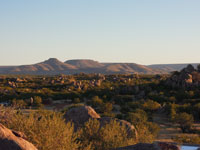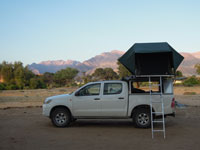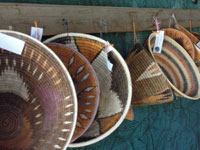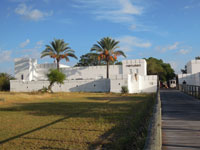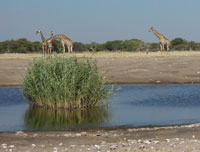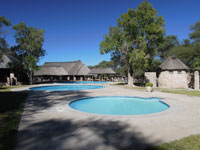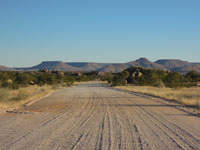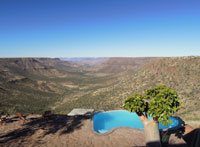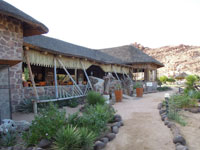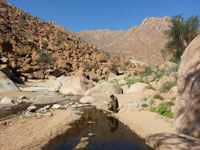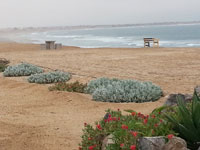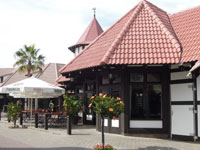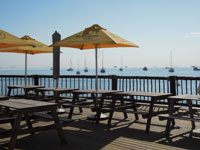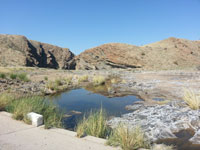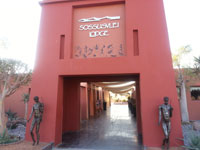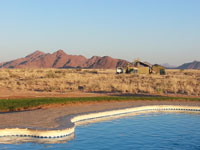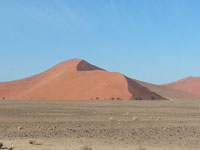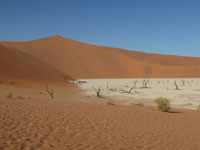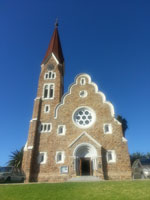Windhoek – Okonjima Game Reserve – Etosha National Park – Hoada – Twyfelfontein – Brandberg – Swakopmund – Sossusvlei – Windhoek
When we mentioned to people we were going to Namibia, there were two distinct reactions. Those who hadn’t been there asked where it was, and those who had been there got a dreamy look in their eyes and said ‘You’ll love it. Wish we could go again.” After a 12-day self-drive camping trip to Namibia, we now know why people love it. Namibia is a beautiful country of magnificent landscapes, wide-open spaces and friendly people. It is relatively unspoilt by tourism and much of the country is sparsely populated. The landscape looks as though it has remained unchanged for centuries.
Unfortunately our trip to Namibia didn’t start well. We missed our flight to the country’s capital, Windhoek, and had to forego our first campsite of the trip. All we can say about that is – if flying from Johannesburg to Windhoek – the South African Airways flight doesn’t leave from the international terminal, and the flight strictly closes one hour before departure! So, arriving in Windhoek a day late, we had much to make up for.
We flew into Windhoek’s Hosea Kutako International Airport – which is about 42 kms east of Windhoek – and were met by Victor from Okavango Guest House & Car Hire. We did a quick grocery shop, sorted out internet connection and picked up our 4WD vehicle.
Okavango Guest House & Car Hire
Before leaving home, we had researched several car hire companies and chose Okavango Car Hire in Windhoek – based on cost and overall positive reviews. We made the right choice! Rudi, Natascha, Leisel and the crew at Okavango Car Hire were exceptional. Not only was the vehicle in peak condition (it had only done 8,000kms) but the advice and briefing before we set off was thorough and invaluable. Our vehicle was a twin-cab 4×4 Toyota Hilux. It was fitted with a rooftop tent, camping gear (including a fridge), cooking equipment and perhaps most importantly – excellent tyres. Most of the roads in Namibia are gravel and good quality tyres are essential.
A special deal at the time included airport transfers and one night’s free accommodation at the Okavango Guest House – amazing value for money for an immaculate vehicle and exceptional service.
Windhoek to Namutoni Rest Camp (Etosha National Park)
The first day of the camping trip was supposed to be a relatively short drive from Windhoek to the Okonjima Game Reserve, home to the AfriCat Foundation, where we were to camp in the Omboroko campsite and spend the afternoon on a tour of the Foundation. However due to missing our flight and running a day late, we cancelled our Omboroko campsite and did a much longer drive – to Namutoni Rest Camp in Etosha National Park. Fortunately the drive was on an excellent bitumen road – the B1.
On the way to Namutoni we made two short stops. Shortly after leaving Windhoek, we stopped at the Okahandja craft markets. There are lots of craft stalls and opposite there are a number of shops – mainly eating places: a Steers burger café, a coffee shop, a biltong shop plus a gift shop, telecommunications shop and large Shell service station. The second stop was at Otavi – for a quick drink and snack at the Total Garage.
Namutoni Rest Camp (Etosha National Park)
We arrived quite late at Namutoni Rest Camp. At reception we were given a map and could choose any campsite we wanted. We chose campsite 16 as it was fairly close to the bathroom block. The campsite had an electric plug, an electric light, a cement table and stools and a fireplace plus metal BBQ. There was also a camp kitchen – all very clean. We felt the campsite was the most attractive facility at Namutoni.
Unfortunately Namutoni Rest Camp is generally quite run down. There are timber walkways (in need of repair) between facilities and the waterhole. The camp is currently undergoing a major refurbishment. Something of note at Namutoni is the small museum opposite Reception. It gives a very good history of Etosha National Park and is worth a visit.
Okaukuejo Rest Camp (Etosha National Park)
We had all day to drive between Namutoni and our next campsite at Okaukuejo. It was a distance of about 134 kms – plenty of time for game viewing. Shortly after leaving Namutoni we had beautiful views across the saltpan. We stopped at various waterholes including Chudop, Okerfontein, Batia and Goas and saw plenty of game – giraffe, gemsbok, kudu, black-faced impala, warthog, zebra, wilderbeest and elephant.
Halali Rest Camp is a good place to stop for lunch. There is a nice restaurant and a well-stocked shop. The campground looks a little barren but other accommodation looks quite good.
After about one hour 20 minutes drive we arrived at Okaukuejo Rest Camp where we were allocated a campsite. It wasn’t the prettiest campsite but had an electric light, an electric plug, stone fire pit and BBQ grid. There were a number of ablution blocks throughout the campsite and we were closest to one that had a camp kitchen, laundry, showers and toilets.
The best thing about the campsite was its close proximity to the waterhole. The Okaukuejo Waterhole is known as one of the best waterholes in Namibia and it is amazing to be able to see animals at such close quarters. On one occasion we saw two young rhinos sparring with each other just in front of us, and on the other side of the waterhole a mother rhino charging a lion that was too close to her calf. It was a still night and the sounds of the snorting; the stamping of hoofs, and the roar of the lions was unforgettable.
Okaukuejo Rest Camp is very attractive with excellent facilities. The camp is well maintained and has a restaurant, swimming pools, post office, curio shop and small grocery shop. The pick of the accommodation is the Waterhole Chalets.
Okaukuejo to Hoada Campsite (Grootberg)
Before leaving Okaukuejo, we saw a wonderful sight – hundreds of zebra came down to drink at the waterhole. We could see the procession in the distance and just had to wait around to see them at close range.
Eventually we set off and the drive that day was one of the most beautiful of all the drives in Namibia. We were headed for the Grootberg area where we had booked a night at the Hoada Campsite.
On the way to Hoada we stopped in the small town of Outjo to stock up on supplies at the OK Supermarket and to fill up with petrol. In Outjo there is a brand new Tourist Information Office with a very good café and gift shop. Great place for lunch. We were keen to make a stop at the Himba village that we knew was located nearby, however the staff at the Tourist Information Office didn’t know anything about it and couldn’t give us directions. We found out later that we had driven right past the turnoff on the way to Hoada! Should have done more research before leaving home.
The drive through the #Khoadi//Hoas conservancy was most interesting – the landscape, local homes, donkey-drawn buggies, etc.
Arriving at the Hoada Campsite we were greeted by the manager who had a beaming smile and welcoming manner. Hoada is a very special place. The campsites are very cleverly located amongst the granite boulders, and local stone has been used to build the ‘bathrooms’. Each campsite is very private. Don’t miss strolling over to visit the pool and bar, hidden amongst a high point in the boulders. Sunset from the bar is a highlight.
Grootberg Lodge
We were very keen to visit nearby Grootberg Lodge, so next morning we made the steep drive up to the lodge where Oti, the Floor Manager, proudly showed us around.
The lodge overlooks one of the most beautiful valleys we have ever seen. Accommodation is in individual, thatched chalets built on the rim of the valley, with the reception, dining room, bar and lounge located in the lodge itself. The swimming pool is beautifully situated. Guests at the lodge can do a number of excursions – one of which is into the valley below to track black rhino. Oti says there are also lion and elephant still roaming wild in the valley.
Twyfelfontein, Damaraland
From Grootberg Lodge we continued on through stunning Damaraland. The landscape was ever changing and as we got closer to Twyfelfontein the red, rocky hills were quite dramatic.
At Twyfelfontein, a UNESCO World Heritage Site, we stopped to see Bushman rock carvings dating back to around 6,000 years. It was a hot walk to see the carvings, along sandy trails and over rocks, with a local guide to show us the way. The tour took about one hour.
The Twyfelfontein Information Centre is itself a work of art. The cleverly designed building is made of local and recycled materials. Recycled steel drums have been used for the roof and for screening. The floors are clay-brick and the walls are made of natural rock in gabions. The Centre houses a museum, gift shop, kiosk and composting toilets. It is a simple, beautiful building in keeping with the landscape.
Nearby there is the Living Museum of the Damara where visitors can experience the culture and lifestyle of the local Damara people. We also visited two natural attractions close by – Burnt Mountain and the Organ Pipes. Elephants still roam this area however we only saw elephant droppings close to the Twyfelfontein Country Lodge. The lodge is an attractive collection of thatched-roof buildings, and is the closest accommodation to the Twyfelfontein Information Centre and rock carvings.
We had a long drive ahead of us and after a quick picnic lunch, set off for Brandberg White Lady Lodge where we had booked a campsite for the night.
Brandberg White Lady Lodge & Camping
It was another beautiful drive between Damaraland and the Brandberg.
The Brandberg mountain is the highest in Namibia and can be seen for miles. For most of the trip it loomed large in the distance – we seemed to do a wide circuit around it, lost site of it for a while, then saw it ahead of us as we approached Brandberg White Lady Lodge. There is a wonderful sense of isolation at the Lodge – it is very attractive and has beautiful views of the mountains. Our campsite was some distance away – on the sandy banks of a dry riverbed. The showers and loos were spotlessly clean and open to the African sky. Next morning one of the staff kindly lit a fire to boil the water for our shower.
White Lady Rock Paintings
The next day we drove about 20 minutes to the start of the walk into see the Bushman rock paintings. It was a beautiful return walk of about 2 hours, mostly following the river – there were stepping stones across the water and rocks to climb over. Most of the walk was in the sun and it was very hot. It’s advisable to wear sturdy shoes and a hat, protect yourself from the sun and take a couple of bottles of water. We thought the walk was worth it just to see the ‘White Lady’ cave however we have since learned that there are a number of other rock paintings close by to see as well.
We left the Brandberg area just after 11am and headed for Swakopmund on the coast. We left the rocky Damaraland landscape and on the C35 towards Henties Bay it became a desert landscape. The road had sandy patches and some unexpected dips, however once we hit the C34, the road was a beautifully smooth ‘salt’ road.
Henties Bay
It was amazing to arrive at the coast after the long, hot, dusty roads of the interior. Henties Bay is a small, town where fishing is very popular – it has been described as a ‘fishing mecca of the Namibian coast’. We had a quick drive around – many of the homes are holiday homes, there is a long sandy beach and there are several cafes, a bank and Spar supermarket.
We continued along the wonderfully smooth C34 road towards Swakopmund – 73kms to the south – the desert and views of the Brandberg on our left, and the Atlantic Ocean on our right. The weather had become noticeably cooler.
Swakopmund
I felt a sense of arriving back in civilization on entering Swakopmund and was looking forward to a real bed and bathroom at Meike’s Guesthouse. We were pleasantly surprised by Swakopmund – it was much bigger than we anticipated with lots of restaurants, shops, attractive buildings and accommodation. We checked in at Meike’s and had a late lunch at the charming Village Café.
We chose Meike’s Guesthouse based on the reviews on TripAdvisor and we cannot recommend it highly enough. It is spotlessly clean, has modern facilities, a pretty garden, and is well located. The owners and staff are very friendly and most hospitable. A continental breakfast was included in our rate.
In the evening we had dinner at The Tug with an Australian couple we had met along the way – in Etosha National Park. We were doing a similar itinerary and had crossed paths many times. The Tug has a wonderful atmosphere and is located on the beach overlooking the Swakopmund Jetty. The food is delicious and servings are generous. Another restaurant we can recommend is the Brauhaus, a German restaurant in The Arcade on Sam Nujoma Drive.
Swakopmund is a pleasant place to stroll around with its many German Colonial buildings, cafes, shops and markets. It is also the adventure capital of Namibia so skydiving, quad biking, sandboarding, horse riding, camel riding, etc, are all available. There are trips to the desert, the dunes, Walvis Bay and Cape Fur Seals at Cape Cross.
We had just two nights in Swakopmund. Our next destination was Sossusvlei – to see the famous dunes. On leaving Swakopmund, the road was excellent with the South Atlantic Ocean on our right and the desert on our left.
Walvis Bay
We made a short stop at the waterfront in Walvis Bay – there are a couple of restaurants and a beautiful shop called Namib where you can buy good quality local crafts, jewellery, scarves, tableware, etc. The waterfront area is part of the natural, deep-water harbour at Walvis Bay – Namibia’s largest commercial port. The town of Walvis Bay is quite a large centre with car dealerships, supermarkets, banks and shops – much bigger than we had anticipated. It had a good feel about it.
Kuiseb Pass & Gaub Pass
From Walvis Bay we drove out on the C14 in the direction of Solitaire. We were heading into the desert again and the drive between Walvis Bay and Sesriem was one of the most beautiful we had done in Namibia. We travelled through the Kuiseb and Gaub passes. They are not steep, mountain passes however they are beautiful – particularly the Kuiseb Pass, which follows the Kuiseb River. Just beyond the Gaub Pass (a very short pass) is the Tropic of Capricorn sign – a popular place for photos. From there it is about 40km to Solitaire where we stopped for lunch.
Solitaire
Solitaire is a tiny settlement with a petrol station, a lodge, restaurant, grocery store, a small dirt airstrip and Moose McGregor’s Desert Bakery. We had read about Moose McGregor but sadly he passed away in January 2014 and was buried nearby. The bakery was still doing a roaring trade with overlanders and tourists like us in 4WDs making up most of the clientele. From Solitaire we had about 80kms drive to Sesriem where we had booked a site at the Sossus Oasis Campsite. We travelled on a wide, gravel road in good condition with lovely views of open, grassy plains and rocky hills on either side.
Sesriem and Sossusvlei
Sesriem is a small settlement at the gate to the Namib-Naukluft National Park. There are 4 options of accommodation at the entrance to the Park:
Immediately outside the Park:
Immediately inside the Park:
There are also plenty of accommodation options further afield. When we were researching our trip to the dunes, we found information on this area quite confusing. We now realise why. The name Sossusvlei is often used to describe the whole area – including the Park and the settlement (Sesriem). However Sossusvlei is one small section of the Namib-Naulkuft National Park – Sossusvlei is actually a salt/clay pan surrounded by dunes.
Another thing we didn’t know was that there are actually two gates to the National Park at Sesriem – an outer gate and an inner gate.
Outer Gate: The outer gate opened at 6am (sunrise).
Inner Gate: Between the outer gate and the inner gate is the Sesriem Campsite. If you stay there, the inner gate opens around 5am so that you can make your way to the dunes and climb them before sunrise.
If you want to be within the National Park (with no gates between you and the dunes), then Sossus Dune Lodge is the only place to stay.
We stayed as Sossus Oasis Campsite (outside both gates). Each campsite has its own shelter, shower, toilet and kitchen sink – very upmarket camping!
We entered the National Park early to see the early morning light on the dunes. The guard at the gate took note of our vehicle registration number (this also happened when we left the Park at the end of the day), we bought a permit from the reception of the Sesriem Campsite, then drove through the inner gate and we were on our way to one of our best days in Namibia! The road in the Park is bitumen (the D872) and it’s 65km to the first carpark (for 2×4 vehicles). Along the way there is some wonderful scenery. Dune 45 (45kms from the entrance gate) is a popular dune to climb.
At the end of the bitumen road there is a sandy road for another 5kms to the 4×4 carpark. If you don’t have a 4×4 vehicle, there are shuttle vehicles to take you in. From that carpark it is popular to walk into Deadvlei. Deadvlei is a white clay pan containing 900 year old, dark camel thorn trees. The contrast between the dead trees and the white clay pan is beautiful together with the surrounding red dunes.
It is a few minutes’ drive across to Sossusvlei, another clay pan surrounded by red dunes. It is a unique and beautiful landscape.
Tip: It’s a good idea to get into the Park as early as possible as by mid morning it is very, very hot. There was no map available of the Park when we bought our permit (we took a photo of the last remaining map on the wall) and there are very few signs in the Park. This is one place where it may be worth having a guide to make the most of the experience.
We had two very comfortable nights at the Sossus Oasis Campsite. On our last night, we treated ourselves to dinner at the nearby Sossusvlei Lodge. Dinner was a magnificent buffet style affair and we dined under the African stars on an outdoor terrace.
Sesriem to Windhoek
We left Sesriem at 8.15am for the drive to Windhoek. On the way back out on the C19 road we saw a lot of gemsbok grazing alongside the road and 3 giraffes – and we weren’t even in a game reserve. After about 13km the C19 joined the C24 and we made a quick turn to join the road towards Rehoboth.
This last day of driving in Namibia was again on a gravel road, with a lot of steep dips. Initially we followed a riverbed then crossed the short Remhoogte Pass and drove through countryside where we saw fences, cattle and the odd farmhouse. Eventually we hit the main bitumen B1 road and it was just 91kms of easy driving to Windhoek.
Windhoek
We arrived in Windhoek for lunch and did a drive around the city which we hadn’t had time to do on our first day. It is a very pleasant city – beautiful location surrounded by mountains. Independence Avenue is the main street of Windhoek and has the main shopping precinct, banks, hotels, etc.
Of interest is the Parliament (Tintenpalast) and gardens, the German-built Christuskirche (Christ Church), the new Independence Museum and the Namibia Craft Centre in the Old Breweries Building. Wernhill Park Mall is good for shopping in the city centre, however we shopped at the Maerua Mall which was a short drive from our accommodation.
We ate at two restaurants while in Windhoek. Firstly, Joe’s Beerhouse which seems to be a Windhoek institution and worth going for the atmosphere alone. The other was Sardinia Blue Olive, an Italian restaurant (Schoemanns Building, Sam Nujoma Drive, Klein Windhoek) where we enjoyed a delicious meal and can highly recommend.
We returned our vehicle to Okavango Car Hire and stayed the last night in the Guest House. The vehicle was checked and washed and all was fine.
The next morning Victor, from Okavango Guest House, drove us to Hosea Kutako International Airport where we caught a flight to Johannesburg. On the flight we sat next to a South African lady who was full of stories about a trip she had recently done to Botswana – the incredible game she had seen, staying in huts built over water where hippos could be heard munching on their food all through the night….I took one look at the “Guru” and could see he was completely hooked and planning his next trip.
Our Tips for Travelling in Namibia:
- Carry cash with you as ATMs are unreliable – often out of order – and not just one but every ATM in town!
- Keep your car topped up with petrol (we found petrol stations only accepted cash).
- Fresh food was more accessible than we realised however it is a good idea to buy plenty of non-perishables before you leave Windhoek.
- If camping, be sure to arrive at your campsite in time to cook dinner before sundown to avoid the bugs.
- The dust is unbelievable. We covered our luggage in large plastic bags. It is advisable to keep food and utensils in dust-proof containers or plastic bags.
- Wear old clothes and shoes – the dust does eventually wash out!
Accommodation Guru, May 2014

